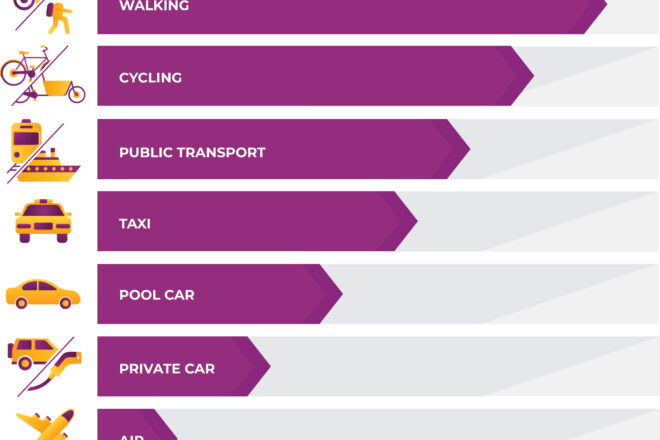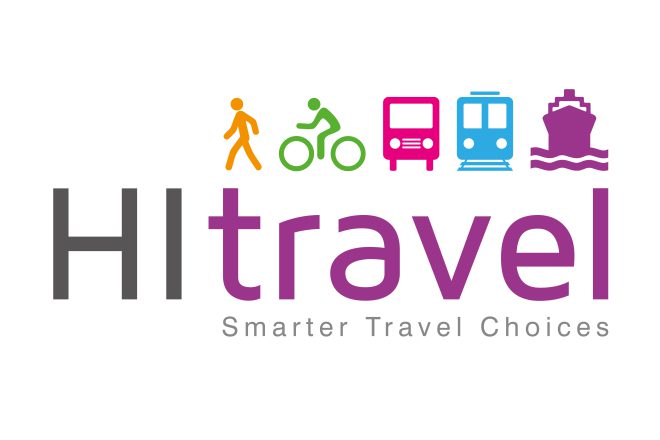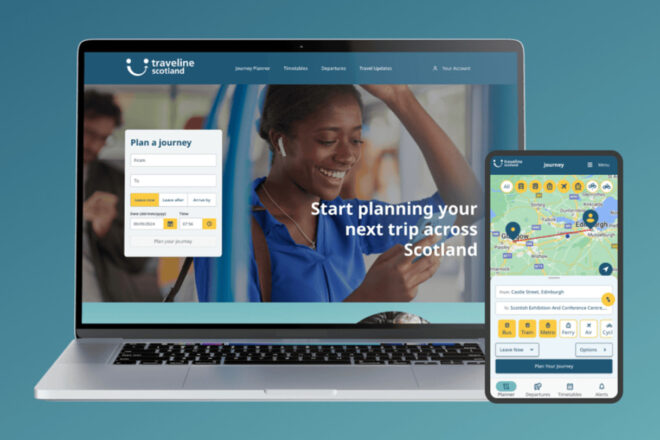Travel Modes
The Scottish National Transport Strategy promotes walking, cycling, public transport, and bike, car and ride sharing, in preference to single occupancy car use. Targeted investment in infrastructure, proactive promotion and improved co-ordination across all modes will achieve the necessary step change in behaviour and attitudes towards transport choices; encouraging demand for active travel and low carbon transport options, and encouraging multimodal journeys as the norm. HITRANS has an important role to play in working with partners to ensure that joined-up transport options provide a successful sustainable travel network across the region.

Active travel refers to walking, wheeling or cycling as a form of transport for getting from A to B. It is non-motorised transport and involves physical activity. It is also a key part of some multi-modal journeys – for example, at the beginning and end of bus or train journeys.
Many settlements in the HITRANS area are compact and walkable, and in many places the proportion of people walking or cycling to work is above the Scottish average.
Cycling is often a safe option if it’s too far or takes too long to walk, and eBikes overcome many of the challenges presented by geography and weather!
The regional Hi-Bike system offers e-bikes to residents and visitors in Inverness and Fort William. HITRANS is currently looking at how to expand the scheme into other towns including Elgin. You can find out more about Hi-Bike here: Hi-Bike
Through the Regional People and Place Programme, supported by Transport Scotland, HITRANS is working in partnership with local authorities and anchor community organiations to deliver an ambitious range behaviour change projects and initiatives to encourage more people to travel sustainably within the region with a focus on specific areas including schools, workplaces and accessibility. HITRANS has developed a Behaviour Change Strategy to guide this work.
Active travel in our area can:
- Provide health benefits, both physical and mental.
- Offer travel options to those without access to a car, and where bus services are infrequent.
- Generate economic benefits by attracting visitors to walk or cycle.
- Reduce emissions, noise pollution and congestion.
Progress has been made in recent years in providing infrastructure, facilities and information to encourage more active travel.
However, there is an ongoing need to offer:
- Measures to increase pedestrians’ and cyclists’ confidence in their personal safety.
- Segregated cycle routes.
- More extensive and better quality pedestrian and cycle networks.
- Design of developments and road transport improvements which meet the needs of pedestrians and cyclists.
- Information about the networks and facilities that are available.
- Convenient and secure cycle parking facilities.
- General information and promotion to continue to shift short journeys from private car to active travel.
Buses play a central role in our area’s public transport network. Bus services in our area encompass:
- Long distance coaches
- Tourist coaches
- Urban services
- Subsidised rural services
- School services which are also made available for use by the public
- Subsidised taxi services and Post Buses
- Dial-a-Ride services.
Bus services provide a potential alternative to the car to everyone in the communities they serve. However, they are particularly important to meet the needs of those who are:
- Unable to drive
- Unable to afford a car
- At particular life stages when they may not have access to a car
- Living in parts of the HITRANS area beyond the rail network
The key issues facing bus service provision include:
- A generally thin network of services.
- Limited frequencies on many routes.
- Congestion in built up areas, compromising service reliability and attractiveness.
- Some areas have no buses at all.
- Integration with other forms of public transport.
- More provision for people with disabilities is required.
Thistle Assistance:
Your Travel Companion
Thistle Assistance is an initiative to help you feel safer and more comfortable when using public transport.
The Thistle Assistance Card and App were developed with the help of transport providers and users to provide a useful means of displaying the right information for the passenger. The Thistle Assistance card and app let transport staff know in an easy and subtle way what extra support you’d like.
Find out more at: Thistle Assistance | Thistle Assistance Thistle Assistance | Your Travel Companion – Discreet public transport support at your fingertips
The HITRANS area has 70 railway stations, representing 20% of all of those in Scotland. Inverness acts a rail hub for the north mainland of the HITRANS area. It has routes south to Edinburgh and Glasgow; east to Aberdeen; north to Thurso & Wick and west to Kyle of Lochalsh. Services to Oban, Fort William and Mallaig are provided from Glasgow.
There was an increase in passengers through much of the 2010s but they have yet to return to pre-pandemic patronage levels. Services now operate from Inverness to/from a range of stations to the north, including Dingwall, Tain and Lairg. These services have catered for growing numbers of commuters into Inverness, as well as providing off peak travel opportunities. In addition, Thurso/Wick and Kyle of Lochalsh services have seen their frequency improved to 4 trains per day, Monday-Saturday, all year round.
In addition to this, there has also been the development of new freight flows, such as retail goods which are distributed onwards to stores within and beyond Inverness. These are in addition to well established flows.
The main role of our area’s rail services are to:
- Provide an alternative to the car.
- Bring visitors to the area, including on the world renowned West Highland and Kyle lines.
- Over longer distances, offer an alternative to flying.
- Increasingly, offer commuting opportunities.
- Connect with other modes.
- Offer some freight traffic a more sustainable form of transport.
The key issues facing rail services include:
- Increasing populations and demand for rail services, including by visitors.
- Low service frequency.
- Poor passenger facilities.
- long journey times which have extended further on some routes in recent years
Ferry services are provided by both public sector operators and private companies. The vast majority of services are procured and funded by the public sector – either Scottish Government or local authorities.
The main operations on the west coast, in terms of number of routes and traffic levels, are the services of Caledonian MacBrayne. In addition some services operating within Argyll & Bute and Highland are operated and/or procured by the local authorities. Orkney has a number of services to the Scottish mainland. Some are publicly supported routes which are provided by Northlink. Others are operated commercially by the private sector and Orkney’s internal ferry services are funded by the local authority.
Private Operators
There are two main private operators in the HITRANS area, in terms of traffic volumes. These are Western Ferries which serves the Cowal peninsula; and Pentland Ferries which connects Orkney with mainland Scotland. Many of the ports used by the ferry services are owned by the public sector. This is either through Caledonian Maritime Assets Limited or local authorities. Some of the ports used by the major ferry services are operated by Trusts, while a number of private facilities are also used.
Freight Services
Bulk freight coastal services largely operate on a commercial basis. They generally cater for lower value and/or higher volume shipments more suited to coastal ships than ferries. Transport Scotland provides financial support to a container service between Aberdeen and Kirkwall.
The main roles of sea & waterborne transport are as follows:
- On many islands ferries are the only regular means of transport for people and goods.
- For some islands and peninsulas ferries are especially important in facilitating daily commuting and access to secondary education.
- Bulk coastal shipping moves economically important goods while reducing road miles compared to the use of ferries.
The main issues facing the ferry network include:
- Fare structures that are inconsistent between different traffic types and between apparently similar routes.
- Limited frequency of sailing on some routes.
- Reduced frequency and length of operating day during the winter.
- On some services, a lack of integration with other forms of public transport.
All of the HITRANS area’s airports that provide scheduled services are publicly owned and funded. There are nine major airports. They are operated by Highlands and Islands Airports Limited, a company wholly owned by the Scottish Ministers. In addition, there are a number of smaller airports and airstrips. These are owned by the local authorities and are used to provide air services within their Council area.
The nine major airports see well over 1 million terminal passengers per year. Inverness is the busiest one, with nearly 1m million terminal passengers. Three (Inverness, Kirkwall and Stornoway) collectively account for around 90% of the major airports’ passengers.
Inverness is the only airport with all year round cross-border and international services. Daily services currently operate to Amsterdam, Heathrow, Gatwick and Luton with services to Manchester and Bristol as well
Passenger Services and Fares
Most scheduled passenger services operate commercially. The exceptions are the intra-local authority flights along with those from Glasgow to Barra, Campbeltown and Tiree and from Wick to Aberdeen. The timetables and fares for those routes are set through their tendering by the public sector, with subsidy provided for them. This is via PSOs (Public Service Obligations). On other intra-Scottish routes fares for residents of the areas served are provided at reduced rates through the Air Discount Scheme.
Air Freight
The HITRANS area also has scheduled freight services, as well as freight carried in the holds of passenger planes. The main cargoes are mail and newspapers, along with some high value time-sensitive products (such as seafood).
The air services complement the options available for surface travel. In particular they offer:
- Fast passenger travel for what would otherwise be long surface journey times.
- Day trip opportunities to/from major service centres.
- Travel suited to time sensitive business trips.
- Travel suited to some passengers travelling for health treatment.
The key issues facing the air services in our area include:
- The need for more intensive use of the airports and aircraft providing scheduled services. The high fares on non-PSO services paid by those who are not eligible for ADS.
- Providing guaranteed access for flights from our area to major hub airports.
- Managing the environmental impact of aviation without adversely affecting economic growth and sustainability in our communities.
The area covered by the five local authorities who are members of HITRANS contains 8,733 miles of road. This is around one quarter of the Scottish road network. There are no motorways in the area. Some 810 miles are trunk roads. The other 7,923 miles are the responsibility of the local authorities.
The strategic road network connects the area’s regional centres with national gateways. The strategic road network includes links such as the A9, A82, A83 and A96. The regional road network links local centres and regional centres within the HITRANS area. It includes roads such as the A830 and A816.
Roads are the mainstay of our area’s transport network. This reflects:
- Relatively high car ownership, emphasising the importance road travel.
- Use of the road network by bus services and taxis, as well as for cycling and walking.
- In some of our more remote communities, a single road can be their only means of access.
- There is a general aim to increase the amount of freight travelling by more sustainable forms of transport but road remains the dominant mode for freight traffic.
The main issues facing our road network include:
- The need for continuing investment to provide roads of a modern standard that offer safe, reliable travel with suitable overtaking opportunities.
- Ensuring that road network is as safe as possible.
- Routing strategic through traffic away from settlements.
- The pressure placed on the network during the summer peak season. Daily traffic flows in the summer are often more than twice those in the winter months.
- Maintenance and resilience of the road network with many routes having long diversionary routes
- The cost of fuel.



